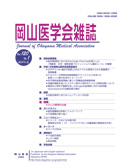

Journal of Okayama Medical Association
Published by Okayama Medical Association<Availability>
Full-text articles are available 3 years after publication.
Permalink : http://escholarship.lib.okayama-u.ac.jp/17421
Electron microscopic study of the histamine effect on granulation tissue growth
Fujiwara, Ryoichi
Published Date
1978-08
Abstract
Daily administration of histamine at 0.5 mg/kg x 2, s.c., and prednisolone at 5 mg/kg, p.o., significantly inhibited growth in granulomas induced by subcutaneous implantation of formalin-soaked filter-paper disks as shown by the lower dry-defatted granuloma weight compared with control group. Electron microscopic observations showed that both histamine and prednisolone decreased the cell density of granulation tissue. In granulomas of rats treated with prednisolone, the development of fibroblast rough endoplasmic reticulum was inhibited, and many lipid droplets were found in these cells. The formation of collagen fibers was significantly inhibited in such granulation tissues. Fibroblasts in granulation tissues from histamine-treated rats showed greater development of rough endoplasmic reticulum and had more mitochondria and dense bodies than fibroblasts of control granulation tissues. The collagen fiber formation in granulation tissue seemed more active in histamine-treated animals than in control animals. In cell counts under the electron microscope, in the period from 3 to 7 days after implantation of filter-paper disks, the percentage of macrophages in granulation tissue decreased to the total number of macrophages, fibroblasts and cells with intermediate characteristics, whereas the count of fibroblasts increased. These time-dependent changes in percentages of macrophages and fibroblasts were accelerated by histamine. These results suggest that histamine mainly through inhibition of cell proliferation, especially of fibroblasts, and acceleration of the differentiation of these fibroblasts inhibits the formation of granulomas.
ISSN
0030-1558
NCID
AN00032489
